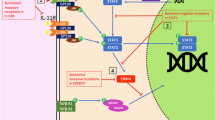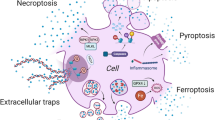Abstract
Objective Immune dysfunction, including prominent apoptosis of immune cells and decreased functioning of the remaining immune cells, plays a central role in the pathogenesis of sepsis. Sterile α and HEAT/armadillo motif-containing protein (SARM) is implicated in the regulation of immune cell apoptosis. This study aimed to elucidate SARM contributes to sepsis-induced immune cell death and immunosuppression. Methods A mouse model of polymicrobial sepsis was generated by cecum ligation and puncture (CLP). SARM gene and protein expression, caspase 3 cleavage and intracellular ATP production were measured in the mouse spleens. Results CLP-induced polymicrobial sepsis specifically attenuated both the gene and protein expression of SARM in the spleens. Moreover, the attenuation of SARM expression synchronized with splenocyte apoptosis, as evidenced by increased caspase 3 cleavage and ATP depletion. Conclusions These findings suggest that SARM is a potential regulator of sepsis-induced splenocyte apoptosis.




Similar content being viewed by others
References
Vincent, J.L., S.M. Opal, J.C. Marshall, and K.J. Tracey. 2013. Sepsis definitions: time for change. Lancet 381: 774–775.
Mayr, F.B., S. Yende, and D.C. Angus. 2014. Epidemiology of severe sepsis. Virulence 5: 4–11.
Zhou, J., C. Qian, M. Zhao, X. Yu, Y. Kang, X. Ma, et al. 2014. Epidemiology and outcome of severe sepsis and septic shock in intensive care units in mainland China. PloS One 9: e107181.
Leentjens, J., M. Kox, J.G. van der Hoeven, M.G. Netea, and P. Pickkers. 2013. Immunotherapy for the adjunctive treatment of sepsis: from immunosuppression to immunostimulation. Time for a paradigm change? American Journal of Respiratory and Critical Care Medicine 187: 1287–1293.
Hotchkiss, R.S., G. Monneret, and D. Payen. 2013. Immunosuppression in sepsis: a novel understanding of the disorder and a new therapeutic approach. Lancet Infectious Diseases 13: 260–268.
Hotchkiss, R.S., G. Monneret, and D. Payen. 2013. Sepsis-induced immunosuppression: from cellular dysfunctions to immunotherapy. Nature Reviews Immunology 13: 862–874.
Condotta, S.A., J. Cabrera-Perez, V.P. Badovinac, and T.S. Griffith. 2013. T-cell-mediated immunity and the role of TRAIL in sepsis-induced immunosuppression. Critical Reviews in Immunology 33: 23–40.
Mink, M., B. Fogelgren, K. Olszewski, P. Maroy, and K. Csiszar. 2001. A novel human gene (SARM) at chromosome 17q11 encodes a protein with a SAM motif and structural similarity to Armadillo/beta-catenin that is conserved in mouse, Drosophila, and Caenorhabditis elegans. Genomics 74: 234–244.
O’Neill, L.A., K.A. Fitzgerald, and A.G. Bowie. 2003. The Toll-IL-1 receptor adaptor family grows to five members. Trends in Immunology 24: 286–290.
O’Neill, L.A., and A.G. Bowie. 2007. The family of five: TIR-domain-containing adaptors in Toll-like receptor signalling. Nature Reviews Immunology 7: 353–364.
Kim, Y., P. Zhou, L. Qian, J.Z. Chuang, J. Lee, C. Li, et al. 2007. MyD88-5 links mitochondria, microtubules, and JNK3 in neurons and regulates neuronal survival. Journal of Experimental Medicine 204: 2063–2074.
Mukherjee, P., T.A. Woods, R.A. Moore, and K.E. Peterson. 2013. Activation of the innate signaling molecule MAVS by bunyavirus infection upregulates the adaptor protein SARM1, leading to neuronal death. Immunity 38: 705–716.
Panneerselvam, P., L.P. Singh, B. Ho, J. Chen, and J.L. Ding. 2012. Targeting of pro-apoptotic TLR adaptor SARM to mitochondria: definition of the critical region and residues in the signal sequence. Biometrical Journal 442: 263–271.
Panneerselvam, P., L.P. Singh, V. Selvarajan, W.J. Chng, S.B. Ng, N.S. Tan, et al. 2013. T-cell death following immune activation is mediated by mitochondria-localized SARM. Cell Death and Differentiation 20: 478–489.
Sethman, C.R., and J. Hawiger. 2013. The innate immunity adaptor SARM translocates to the nucleus to stabilize lamins and prevent DNA fragmentation in response to pro-apoptotic signaling. PLoS One 8: e70994.
Wichterman, K.A., A.E. Baue, and I.H. Chaudry. 1980. Sepsis and septic shock—a review of laboratory models and a proposal. Journal of Surgical Research 29: 189–201.
Zou, L., Y. Feng, Y.J. Chen, R. Si, S. Shen, Q. Zhou, et al. 2010. Toll-like receptor 2 plays a critical role in cardiac dysfunction during polymicrobial sepsis. Critical Care Medicine 38: 1335–1342.
Zou, L., Y. Feng, Y. Li, M. Zhang, C. Chen, J. Cai, et al. 2013. Complement factor B is the downstream effector of TLRs and plays an important role in a mouse model of severe sepsis. Journal of Immunology 191: 5625–5635.
Zou, L., Y. Feng, M. Zhang, Y. Li, and W. Chao. 2011. Nonhematopoietic toll-like receptor 2 contributes to neutrophil and cardiac function impairment during polymicrobial sepsis. Shock 36: 370–380.
Schmittgen, T.D., and K.J. Livak. 2008. Analyzing real-time PCR data by the comparative C(T) method. Nature Protocols 3: 1101–1108.
Livak, K.J., and T.D. Schmittgen. 2001. Analysis of relative gene expression data using real-time quantitative PCR and the 2(-Delta Delta C(T)) Method. Methods 25: 402–408.
Poli-de-Figueiredo, L.F., A.G. Garrido, N. Nakagawa, and P. Sannomiya. 2008. Experimental models of sepsis and their clinical relevance. Shock 30(Suppl 1): 53–59.
Carty, M., R. Goodbody, M. Schroder, J. Stack, P.N. Moynagh, and A.G. Bowie. 2006. The human adaptor SARM negatively regulates adaptor protein TRIF-dependent Toll-like receptor signaling. Nature Immunology 7: 1074–1081.
Belinda, L.W., W.X. Wei, B.T. Hanh, L.X. Lei, H. Bow, and D.J. Ling. 2008. SARM: a novel Toll-like receptor adaptor, is functionally conserved from arthropod to human. Molecular Immunology 45: 1732–1742.
Peng, J., Q. Yuan, B. Lin, P. Panneerselvam, X. Wang, X.L. Luan, et al. 2010. SARM inhibits both TRIF- and MyD88-mediated AP-1 activation. European Journal of Immunology 40: 1738–1747.
Hou, Y.J., R. Banerjee, B. Thomas, C. Nathan, A. Garcia-Sastre, A. Ding, et al. 2013. SARM is required for neuronal injury and cytokine production in response to central nervous system viral infection. Journal of Immunology 191: 875–883.
Gerdts, J., D.W. Summers, Y. Sasaki, A. DiAntonio, and J. Milbrandt. 2013. Sarm1-mediated axon degeneration requires both SAM and TIR interactions. Journal of Neuroscience 33: 13569–13580.
Summers, D.W., A. DiAntonio, and J. Milbrandt. 2014. Mitochondrial dysfunction induces Sarm1-dependent cell death in sensory neurons. Journal of Neuroscience 34: 9338–9350.
Yu, X.M., and L. Luo. 2012. Neuroscience. dSarm-ing axon degeneration. Science 337: 418–419.
Osterloh, J.M., J. Yang, T.M. Rooney, A.N. Fox, R. Adalbert, E.H. Powell, et al. 2012. dSarm/Sarm1 is required for activation of an injury-induced axon death pathway. Science 337: 481–484.
Szretter, K.J., M.A. Samuel, S. Gilfillan, A. Fuchs, M. Colonna, and M.S. Diamond. 2009. The immune adaptor molecule SARM modulates tumor necrosis factor alpha production and microglia activation in the brainstem and restricts West Nile Virus pathogenesis. Journal of Virology 83: 9329–9338.
Murata, H., M. Sakaguchi, K. Kataoka, and N.H. Huh. 2013. SARM1 and TRAF6 bind to and stabilize PINK1 on depolarized mitochondria. Molecular Biology of the Cell 24: 2772–2784.
Chang, S.C., and J.L. Ding. 2014. Ubiquitination by SAG regulates macrophage survival/death and immune response during infection. Cell Death and Differentiation 21: 1388–1398.
Acknowledgments
This work was supported financially by Guangzhou Medical University (2011C43), the Third Affiliated Hospital of Guangzhou Medical University (2012Y20), and Department of Education of Guangdong Province (2015KQNCX137).
Author Contributions
Y.G. designed and did experiments, analyzed data, and wrote the manuscript. L.Z. and DZ.C. helped with the experiments. W.C. and DJ.C.contributed reagents and suggestions.
Author information
Authors and Affiliations
Corresponding authors
Ethics declarations
All of the animal care and procedures were performed according to the protocols approved by the Animal Experimental Committee of Guangzhou Medical University or the Subcommittee on Research Animal Care of Massachusetts General Hospital and were in accordance with the Guangdong Animal Center guidelines for the ethical treatment of animals or the “Guide for the Care and Use of Laboratory Animals” published by the National Institutes of Health.
Conflict of Interest
The authors declare that they have no conflict of interests.
Rights and permissions
About this article
Cite this article
Gong, Y., Zou, L., Cen, D. et al. Reduced Expression of SARM in Mouse Spleen during Polymicrobial Sepsis. Inflammation 39, 1930–1938 (2016). https://doi.org/10.1007/s10753-016-0428-x
Published:
Issue Date:
DOI: https://doi.org/10.1007/s10753-016-0428-x




